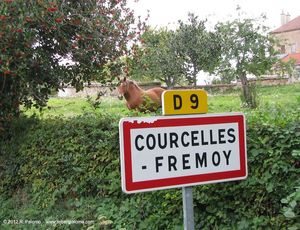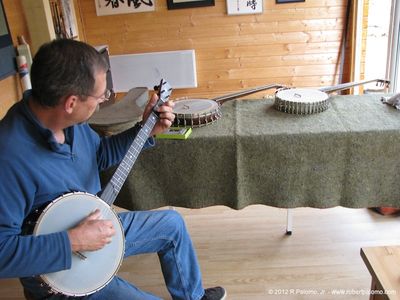 Winding along a country road through the placid rolling hills of Burgundy with it's vine-laden slopes and pastures where the ever-present white Charolais cattle browse the hillsides, still green even in mid-October, our GPS, borrowed from a friend in St. Petersburg, thinks it knows where we're headed.
Winding along a country road through the placid rolling hills of Burgundy with it's vine-laden slopes and pastures where the ever-present white Charolais cattle browse the hillsides, still green even in mid-October, our GPS, borrowed from a friend in St. Petersburg, thinks it knows where we're headed.
But our 2005 Michelin atlas shows a different road number for the road we seem to be on, and the way looks shorter than the opinion offered by the навигатер ("navigator"). The road dips down into a hollow, winds beside a small stream for several kilometers, then up a steep hill, around a sharp bend and suddenly, voilà- the standard red and white sign informs us we have in fact found our way to the tiny village of Courcelles-Fremoy. Our dinky blue soap-bubble of a Citroën is welcomed by a big brown horse who regards us from his leafy paddock.
We round the bend into the village proper, following the GPS and looking for the address I'm seeking. We take a sharp right turn according to instructions, but miss the street sign. It's there, but not readily visible turning from the direction we're coming from. It seems like more of a catty-corner short alley-way than a street. The buildings look as ancient as I will later learn they actually are, and we don't see any house number on the one which, according to Madame GPS, should be the one we're looking for.
We reach the end of the tiny street and turn back toward the village center wondering "what now?" Madame GPS recalculates the route and insists on the same turn we already took. We creep down the street again, looking at the building we think must be the place, but which on the street side presents a mostly blank wall (the entrance will turn out to be in the rear). We get to the end of the street again, but this time, where the alleged destination building ends, I spot a small, modern-looking out-building, log-cabin style, with big windows and a big glass door through which I see — banjos!
This is the place I've been hunting for... the workshop of French luthier Eric Stefanelli. It's one of the last places on earth that I, an American with Ozark mountain roots, would have thought to find a master builder of classic American banjos. And yet, it's somehow most apropos that this instrument, with it's country-folk roots, should be found in this idyllic rural setting far from its origins.
As I open the gate I'm greeted by a bespectacled gent with a graying goatee who welcomes my wife Diana and me into his small, neatly arranged workshop where one of his "Basic" model open-back banjos is being readied for delivery to a customer. I've come from Paris to deliver an old Vega Style F tenor banjo I recently acquired, for which I've hired Eric to build a 5-string conversion neck. After looking over this 1920's vintage banjo, which Eric's masterly eye finds in amazingly good condition, he proceeds to show me some of the fruits of his craftsmanship.
A devotee of "old-time" clawhammer and ragtime banjo, Eric specializes in recreating several classic American banjos from the late 19th and early 20th centuries. In all my years of salivating over beautiful handmade musical instruments, I can't recall seeing better craftsmanship than what I'm seeing in this tiny French village, well off the beaten tourist path. The finish work in particular is amazing, and I learn that Eric shuns factory-made spray-on finishes, preferring the so-called "French polish" technique, and concocting his own oils and varnishes. A whiff of the latter reveals the presence of a distillate of the famed regional vintages.
Business and workshop tour completed, Eric invites us for coffee in his adjacent home. This proves to be a 400-year old stone structure still in the process of renovation, which Eric works on between orders for custom instruments and banjo restoration and repair work. Inside we meet Eric's wife Patricia, and while the ladies go off on a tour of the domicile, I'm treated to a tour of Eric's collection of vintage open-back banjos, which sit on stands on the original brick floor, behind recently-exposed rustic partition studs of ancient wood. This simply begs the question: how did a middle-age French gent in this lovely out of the way corner of France get into playing and making banjos?
"I've been around banjos most of my life," says Eric. "My grandfather was a (merchant) sailor who frequently landed in Savannah, Georgia where he was exposed to American old-time and ragtime banjo. He bought several banjos on voyages to the States. While in port he would take some lessons, and then practice on the voyages back to France. He started teaching me when I was a boy. Later, as I became interested in woodworking, I just naturally found myself combining banjo playing and building. I'm fortunate that I've been able to make a business from it."
But I discovered that banjos are not his only product. In addition to performing as a banjo duet with his wife, Patricia, which has taken them as far as Japan, Eric is also a "luthier" in the original sense: he build lutes.
"Patricia is a lute player and she got me interested in building them," he says. I had seen lutes and heard them played during my student years at Indiana University's school of music, but that didn't prepare me for what Patricia showed and played for us: an incredible "theorbo". More that 2 meters long, it was unbelievably lightweight and amazingly balanced.
By this time, we were getting well into "midi" — the two hours between noon and 2 pm when, in rural France, everything stops for lunch... and you'd better too if you want anything to eat before restaurants reopen for dinner. Eric and Patricia suggested a place in a nearby village that specialized in regional cuisine. This turned out to be a lovely old "auberge" (inn) with seating around the original old fireplace hung with copper cookware which had my wife, a devotee of French "brocante" (antiques or junk, take your pick), longing for more than just food. I realized that if I was ever going to sample truly authentic Boef à la Bourguignonne now was the time... and so it proved!
After lunch we bade adieu to our new-found French friends, leaving the Vega banjo and various parts with Eric and moving on towards a scheduled rendezvous with our Paris-based daughter, from whom via circuitous machinations, it eventually got back home to St. Petersburg. It was a long wait, but that only made my "banjo à la Bourguignonne" all the more special.
The finished Burgundy Banjo





